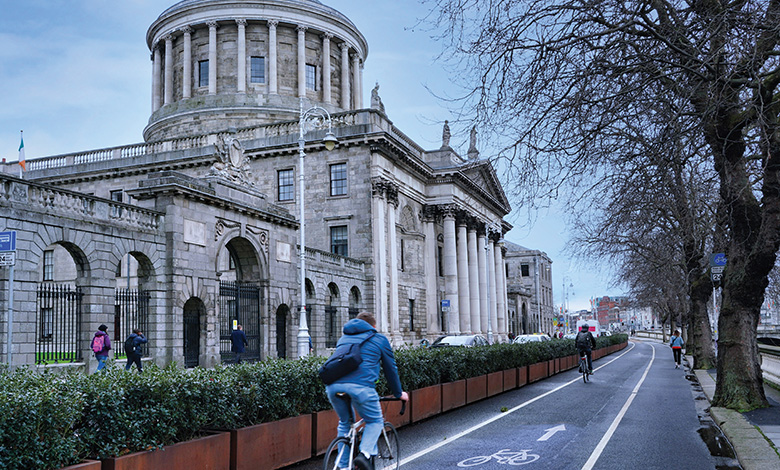ESRI: Active travel outcomes ‘have more positive effects than people expect’

A study by the Economic and Social Research Institute (ESRI) states that if the benefits of cycle lanes in cities are to be maximised, that these must be enabled by traffic calming measures and segregation infrastructure.
The study highlights enabling infrastructure that would provide an increase in the already relatively successful phenomenon of active travel.
“Dedicated infrastructure that allows cyclists to complete full journeys while feeling safe increases cycling, particularly among women and older people who are otherwise less likely to cycle,” the ESRI states.
“Cycle lanes that are segregated from other traffic, painted and are given priority by lights at intersections boost real and perceived safety for both cyclists and pedestrians. These benefits are greater when initiatives are accompanied by traffic calming measures, such as reduced speed limits and raised crossings at intersections.”
Asserting that the impact of active travel schemes is “often more positive than people expect”, the study, undertaken by the ESRI’s Behavioural Research Unit, reviews international evidence on the effects of infrastructure changes designed to promote cycling and walking, including the impact on communities and public opinion.
The ESRI further finds that there is strong international evidence that improving active travel facilities boosts rates of cycling and walking.
“Knock-on effects on local food and retail businesses tend to be positive or neutral, while such schemes can also reduce traffic congestion.”
Overcoming initial public opposition
Despite benefits of reduced emissions, better air quality, and improved public health, the ESRI is cognisant of the fact that proposals to alter existing infrastructure to facilitate active travel frequently face opposition from communities, usually based on negative expectations about the effects on businesses and traffic.
The report authors state that active travel infrastructure “has large potential to decrease car dependency and promote healthier, more sustainable communities”.
“Planning and design decisions determine the scale of effectiveness. Achieving the goal of behaviour change is made more likely by incorporating evidence from psychology and other behavioural sciences,” they state.
On the phenomenon of negativity towards the construction or promotion of new active travel infrastructure, the review points to multiple psychological biases that it asserts “may hinder support”, including what it describes as “status quo bias” i.e. the preference for things to remain the same even if change is proven to be beneficial.
The report further cites “primary effects” i.e. overweighting of the first piece of information based on who it comes from rather than what it contains; “messenger effects” i.e. evaluations of information based on who it comes from rather than what it contains; and “collective illusion”, i.e. belief among supporters of schemes that they are in a minority, as possible explanations for the failure to maximise public support for schemes likely to be beneficial.
The report asserts that there is “strong evidence” that connectivity, proximity, and safety should be “prioritised over other design elements”. “Segregated, painted, one-way cycle lanes, dedicated priority lights at intersections, advance stop lines, traffic calming measures and direct routes accessible only by walkers and cyclists are ways to maximise perceived and objective safety – and in turn usage,” the report states.
In light of this, the ESRI authors called for the early planning new active travel schemes which they say “needs to begin with early communication undertaken within an open and fair consultation”.
“Ideally, messages should aim to challenge status quo bias and would aim to help local citizens to make up their minds about the benefits and disadvantages of change based on accurate perceptions and expectations. In particular, impacts on traffic, local businesses, and safety should be addressed.”
The study, formally titled, Active travel infrastructure design and implementation: Insights from behavioural science, was authored by Shane Timmons, senior research officer with the ESRI’s Behavioural Research Unit, and was commissioned by the National Transport Authority and Fingal County Council.
Speaking following the publication of the report, Timmons said: “In multiple countries, research finds that people become more positive about changes once they are implemented. Open and fair consultations with communities to address concerns about traffic, local businesses and safety are helpful.
“Policy can benefit from more targeted research on how communities anticipate and respond to change.”





